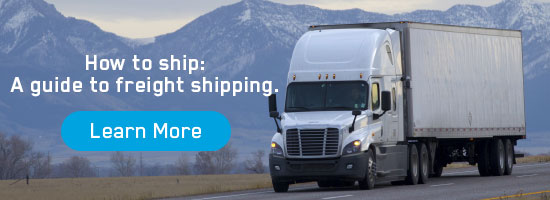Breaking down freight shipping basics.
November 5, 2018

Who knew that freight shipping could be so complex? The freight industry is multi-faceted and ever-changing and navigating the intricacies of the shipping world can be an overwhelming task. Before you begin your freight shipping journey, it is important to know all of the basics.
Fortunately for shippers, we here at Freightquote by C.H. Robinson are ready to handle the details for you. Shippers don’t have to worry about missing something – a cheaper option, a legal issue, a strange surcharge – because Freightquote takes care of everything. And there is a lot to take care of. Let’s break down the freight shipping basics to get you started.
What is freight?
“Freight” is the transfer of goods, generally on a commercial level. Goods are categorized in several different ways before a shipping channel is determined.
Things to consider about the goods at the beginning of the shipping process:
- The nature of the goods – household goods, grain, hazardous materials, liquid, large machinery, etc.
- Size and quantity of the goods
- Time of delivery – do you need it there next month, next week or next day?
- Packaging – can the goods be boxed, crated or pallet-ized?
- Destination – domestic, international, intra-state?
Working with a freight service provider such as Freightquote can help guide you through this process if you are unsure of any of these considerations. When you have a full picture of what type of shipment you’re dealing with, we can make a recommendation as to what freight shipping option should be used. And there are several to choose from:
Parcel carriers
Companies like UPS and FedEx that deliver small packages and envelopes that are referred to as parcels. Often even larger household goods can be economically shipped via a parcel carrier.
Less than truckload (LTL) freight
Available for relatively small shipments of multiple items. In LTL freight, a 28-foot container (or trailer) holds shipments for several different shippers, consolidated into one shipment by destination, class and delivery time requirements.
Truckload (TL) freight
Available for any shipment larger than about 15,000 pounds. The most economical way to ship these large loads is via its own truck. TL shipments generally deliver on exactly the same trailer as they are picked up on. TL shipments can also utilize specialized equipment like refrigerated trailers, liquid containers and flatbed decks.
Air freight
Shipping via airplane is available for just about every type of freight that can be shipped LTL – at a quicker pace and a higher rate.
Rail freight
The shipment of goods via railway. This is an economical means of transport for almost anything that could be otherwise shipped LTL or TL. Often, rail freight is part of an intermodal process in which the freight starts and ends on the back of a truck – with other modes of transport in the middle.
Ocean or barge freight
Available when freight must traverse a body of water. Large ocean-going vessels move freight intercontinentally, usually in corrugated containers. Domestically, certain freight moves on major river channels such as the Mississippi.
What comes next.
After the mode of transport is chosen, the shipper must then wade through pricing, tariffs, discounts and surcharges before even booking a shipment. Fortunately, shippers using online freight service providers don’t have to deal with this hassle. Contact us today to learn more about how to get started.
Freightquote’s technology allows shippers to compare bottom line freight rates “apples to apples” with the touch of a button. Instantaneous freight quotes are just the start though – as the same system allows a shipper to book a load, create legally-required shipping documents, track a delivery and pay a shipping invoice.
Image Credit: https://www.istockphoto.com/portfolio/suriyasilsaksom
Topics:
Get Your Shipping Quote

